child lock FORD F650/750 2023 Owners Manual
[x] Cancel search | Manufacturer: FORD, Model Year: 2023, Model line: F650/750, Model: FORD F650/750 2023Pages: 378, PDF Size: 5.65 MB
Page 5 of 378
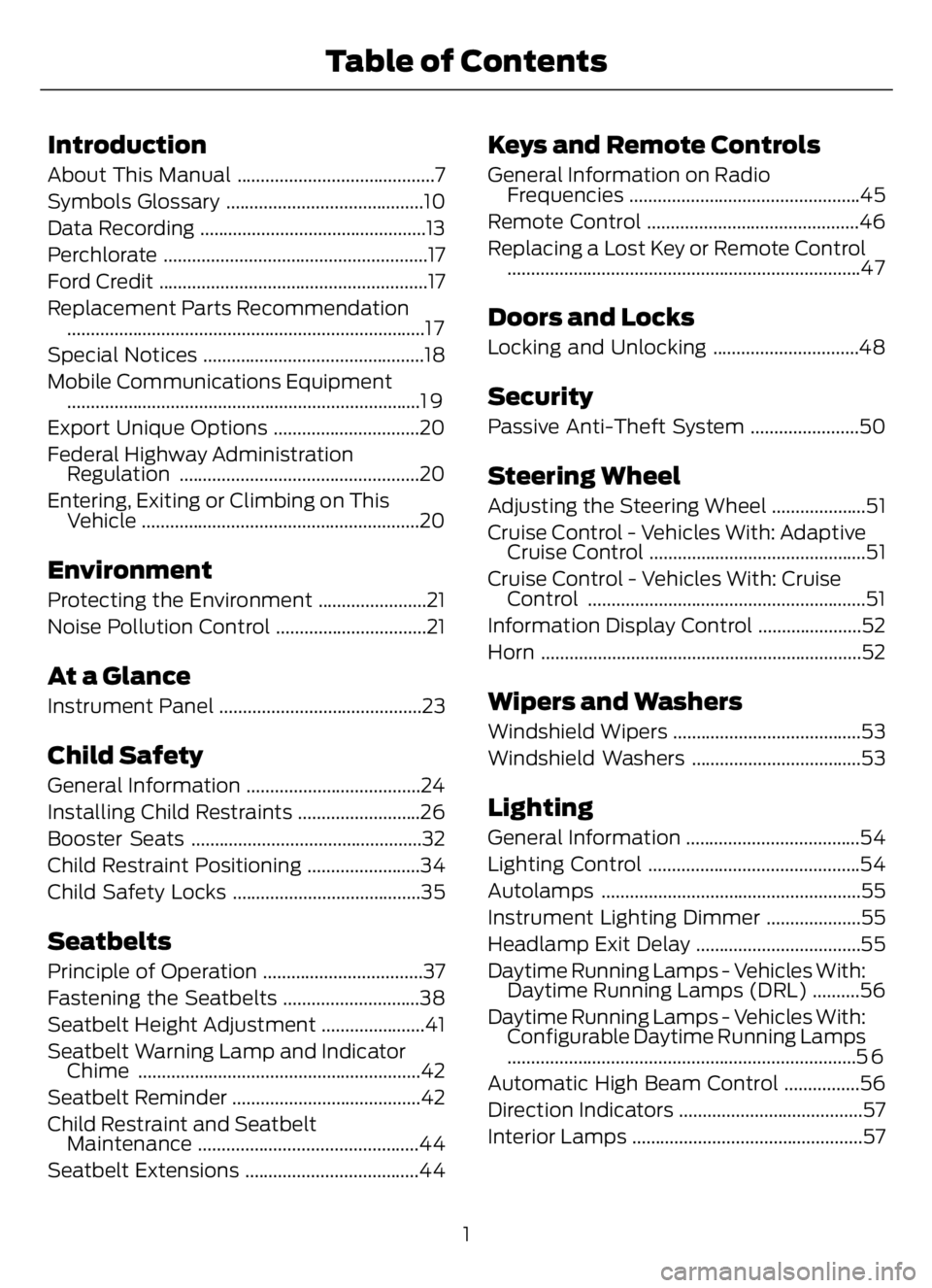
Introduction
About This Manual ..........................................7
Symbols Glossary ..........................................10
Data Recording ................................................13
Perchlorate ........................................................17
Ford Credit .........................................................17
Replacement Parts Recommendation
............................................................................1 7
Special Notices ...............................................18
Mobile Communications Equipment
...........................................................................1 9
Export Unique Options ...............................20
Federal Highway Administration
Regulation ...................................................20
Entering, Exiting or Climbing on This
Vehicle ...........................................................20
Environment
Protecting the Environment .......................21
Noise Pollution Control ................................21
At a Glance
Instrument Panel ...........................................23
Child Safety
General Information .....................................24
Installing Child Restraints ..........................26
Booster Seats .................................................32
Child Restraint Positioning ........................34
Child Safety Locks ........................................35
Seatbelts
Principle of Operation ..................................37
Fastening the Seatbelts .............................38
Seatbelt Height Adjustment ......................41
Seatbelt Warning Lamp and Indicator
Chime ............................................................42
Seatbelt Reminder ........................................42
Child Restraint and Seatbelt
Maintenance ...............................................44
Seatbelt Extensions .....................................44
Keys and Remote Controls
General Information on Radio
Frequencies .................................................45
Remote Control .............................................46
Replacing a Lost Key or Remote Control
...........................................................................47
Doors and Locks
Locking and Unlocking ...............................48
Security
Passive Anti-Theft System .......................50
Steering Wheel
Adjusting the Steering Wheel ....................51
Cruise Control - Vehicles With: Adaptive
Cruise Control ..............................................51
Cruise Control - Vehicles With: Cruise
Control ...........................................................51
Information Display Control ......................52
Horn ....................................................................52
Wipers and Washers
Windshield Wipers ........................................53
Windshield Washers ....................................53
Lighting
General Information .....................................54
Lighting Control .............................................54
Autolamps .......................................................55
Instrument Lighting Dimmer ....................55
Headlamp Exit Delay ...................................55
Daytime Running Lamps - Vehicles With:
Daytime Running Lamps (DRL) ..........56
Daytime Running Lamps - Vehicles With:
Configurable Daytime Running Lamps
..........................................................................5 6
Automatic High Beam Control ................56
Direction Indicators .......................................57
Interior Lamps .................................................57
1
Table of Contents
Page 15 of 378

E162384E162384Air conditioning system
E231157
Air conditioning system lubricant
type
Anti-lock braking system
Avoid smoking, flames or sparks
Battery
Battery acid
Brake fluid - non petroleum
based
Brake system
E270480
Brake system
E139223E139223Cabin air filter
Check fuel cap
Child safety door lock or unlock
Child seat lower anchor
E141E141128128Child seat tether anchor
E71340
Cruise control
Do not open when hot
Engine air filter
Engine coolant
Engine coolant temperature
Engine oil
Explosive gas
Fan warning
E71880
Fasten seatbelt
E231160
Flammable
E67017
Front airbag
Front fog lamps
Fuel pump reset
Fuse compartment
Hazard flashers
Heated rear window
11
Introduction
Page 16 of 378
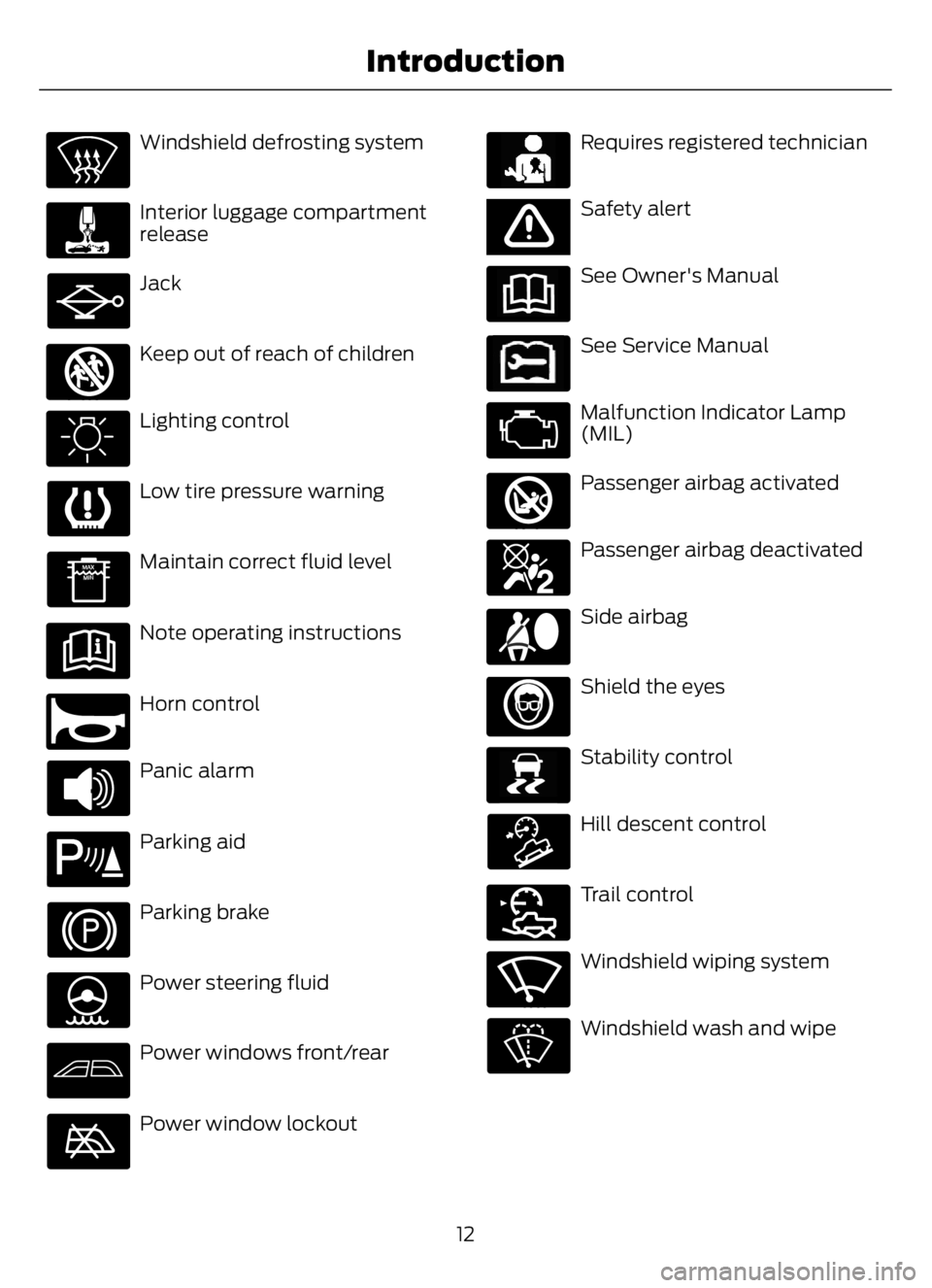
Windshield defrosting system
Interior luggage compartment
release
Jack
E161353
Keep out of reach of children
Lighting control
Low tire pressure warning
Maintain correct fluid level
Note operating instructions
E270945
Horn control
Panic alarm
E139213
Parking aid
Parking brake
Power steering fluid
Power windows front/rear
Power window lockout
E231159
Requires registered technician
E65963E65963Safety alert
See Owner's Manual
E231158
See Service Manual
Malfunction Indicator Lamp
(MIL)
E270849
Passenger airbag activated
E270850
Passenger airbag deactivated
Side airbag
Shield the eyes
E138639
Stability control
E163957
Hill descent control
E272858
Trail control
E270969
Windshield wiping system
Windshield wash and wipe
12
Introduction
Page 30 of 378
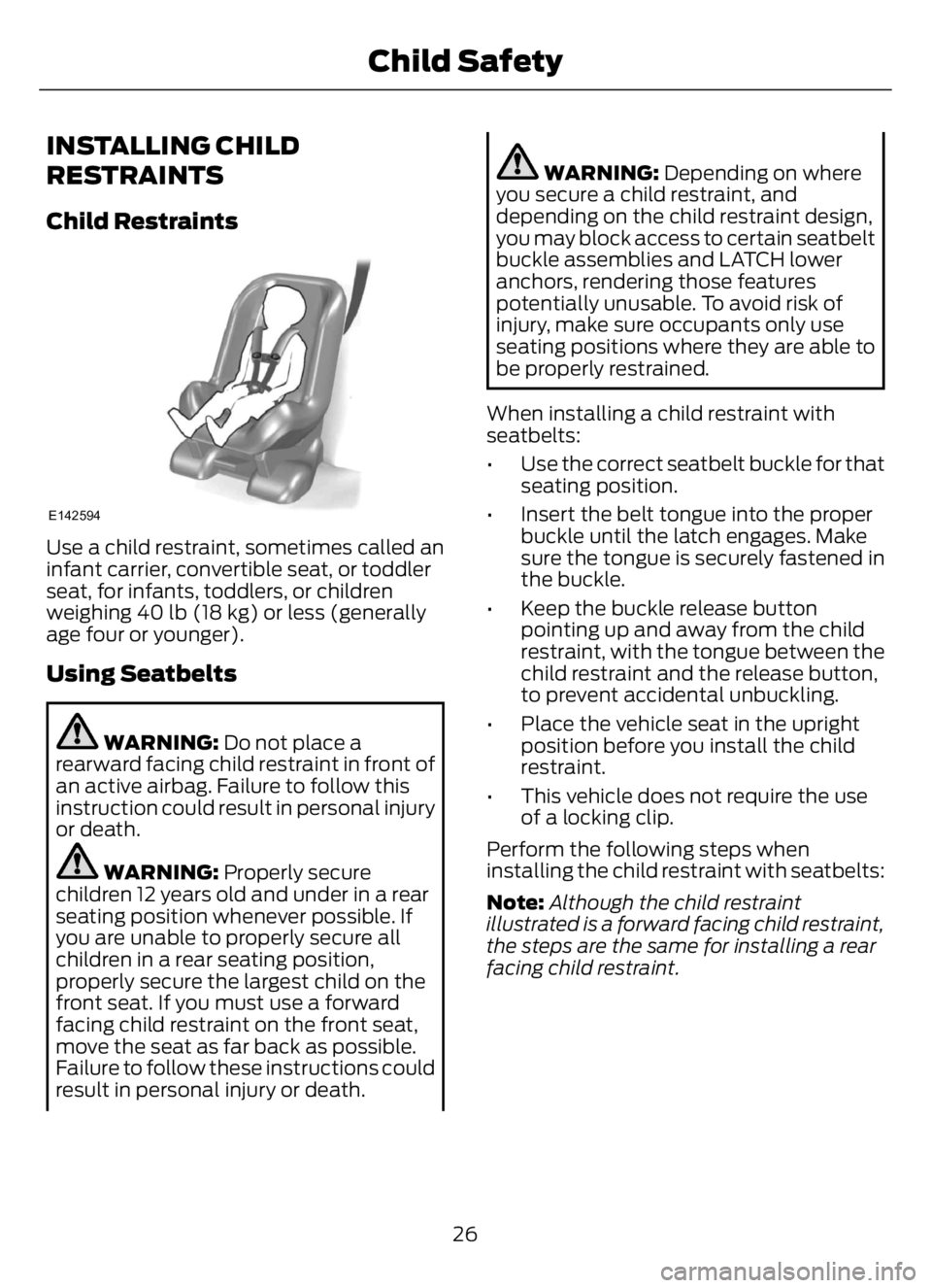
INSTALLING CHILD
RESTRAINTS
Child Restraints
E142594
Use a child restraint, sometimes called an
infant carrier, convertible seat, or toddler
seat, for infants, toddlers, or children
weighing 40 lb (18 kg) or less (generally
age four or younger).
Using Seatbelts
WARNING: Do not place a
rearward facing child restraint in front of
an active airbag. Failure to follow this
instruction could result in personal injury
or death.
WARNING: Properly secure
children 12 years old and under in a rear
seating position whenever possible. If
you are unable to properly secure all
children in a rear seating position,
properly secure the largest child on the
front seat. If you must use a forward
facing child restraint on the front seat,
move the seat as far back as possible.
Failure to follow these instructions could
result in personal injury or death.
WARNING: Depending on where
you secure a child restraint, and
depending on the child restraint design,
you may block access to certain seatbelt
buckle assemblies and LATCH lower
anchors, rendering those features
potentially unusable. To avoid risk of
injury, make sure occupants only use
seating positions where they are able to
be properly restrained.
When installing a child restraint with
seatbelts:
• Use the correct seatbelt buckle for that
seating position.
• Insert the belt tongue into the proper
buckle until the latch engages. Make
sure the tongue is securely fastened in
the buckle.
• Keep the buckle release button
pointing up and away from the child
restraint, with the tongue between the
child restraint and the release button,
to prevent accidental unbuckling.
• Place the vehicle seat in the upright
position before you install the child
restraint.
• This vehicle does not require the use
of a locking clip.
Perform the following steps when
installing the child restraint with seatbelts:
Note:Although the child restraint
illustrated is a forward facing child restraint,
the steps are the same for installing a rear
facing child restraint.
26
Child Safety
Page 31 of 378
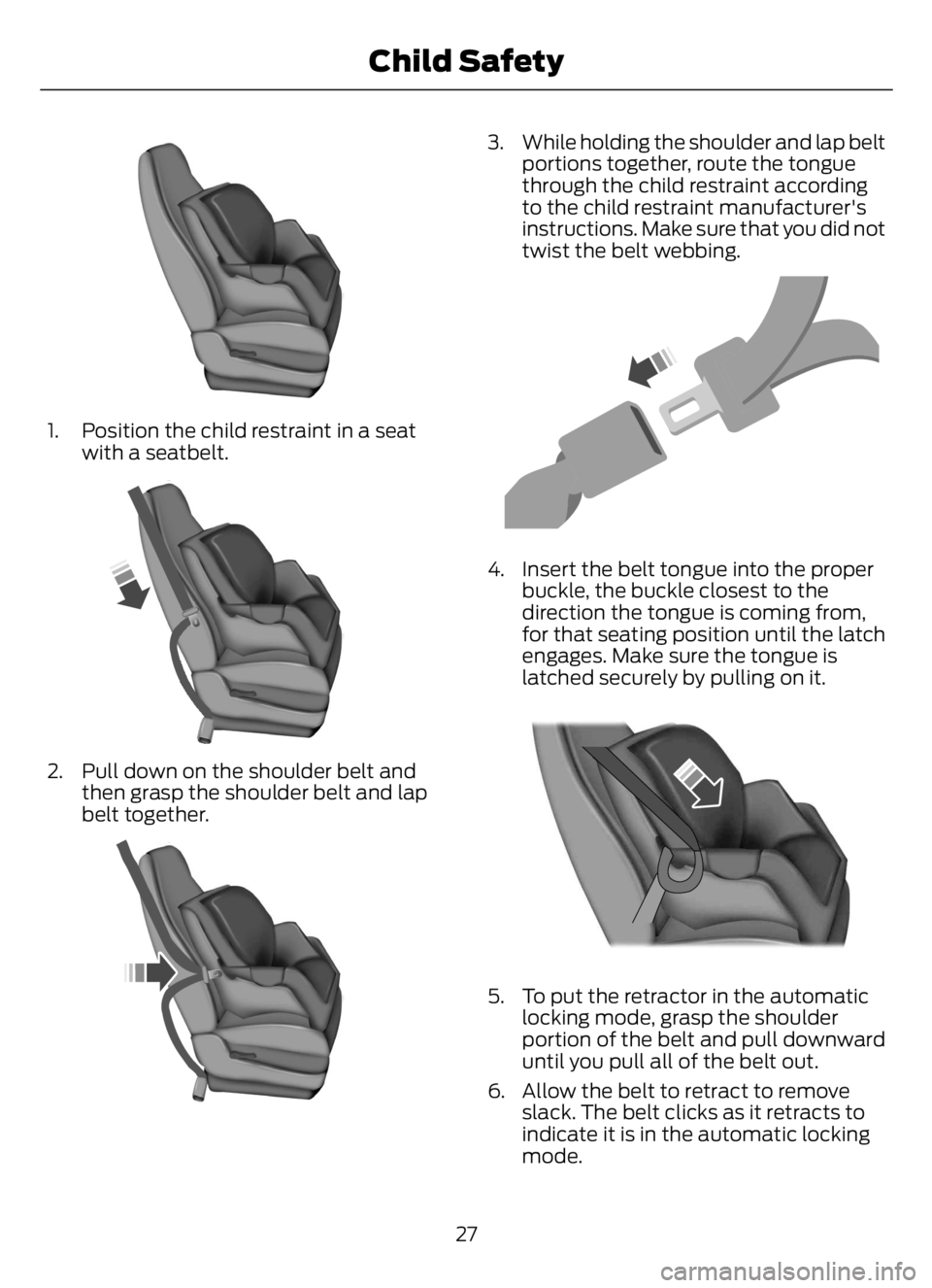
E142528
1. Position the child restraint in a seat
with a seatbelt.
E142529
2. Pull down on the shoulder belt and
then grasp the shoulder belt and lap
belt together.
E142530
3. While holding the shoulder and lap belt
portions together, route the tongue
through the child restraint according
to the child restraint manufacturer's
instructions. Make sure that you did not
twist the belt webbing.
4. Insert the belt tongue into the proper
buckle, the buckle closest to the
direction the tongue is coming from,
for that seating position until the latch
engages. Make sure the tongue is
latched securely by pulling on it.
E142875
5. To put the retractor in the automatic
locking mode, grasp the shoulder
portion of the belt and pull downward
until you pull all of the belt out.
6. Allow the belt to retract to remove
slack. The belt clicks as it retracts to
indicate it is in the automatic locking
mode.
27
Child Safety
Page 32 of 378
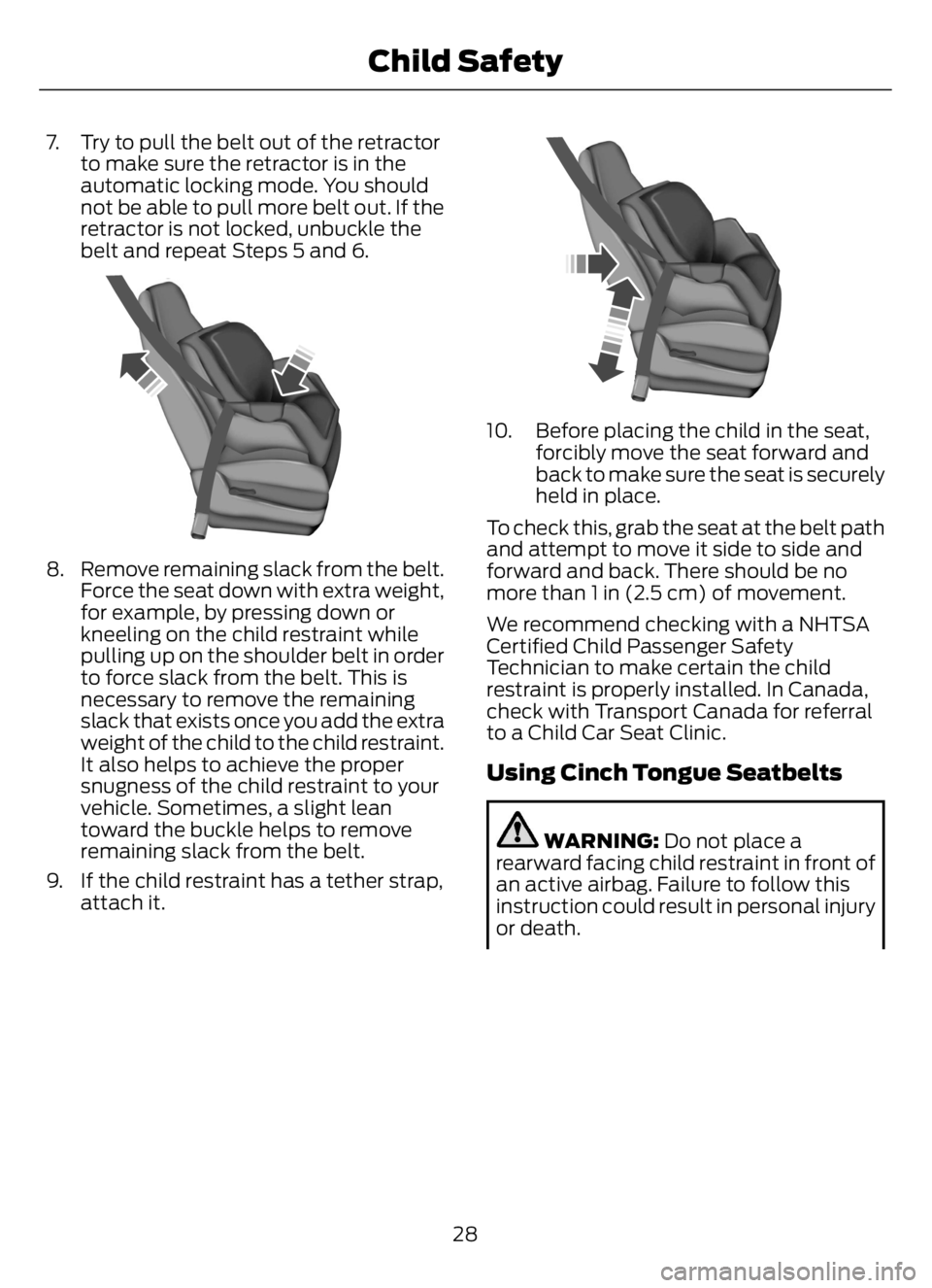
7. Try to pull the belt out of the retractor
to make sure the retractor is in the
automatic locking mode. You should
not be able to pull more belt out. If the
retractor is not locked, unbuckle the
belt and repeat Steps 5 and 6.
E142533
8. Remove remaining slack from the belt.
Force the seat down with extra weight,
for example, by pressing down or
kneeling on the child restraint while
pulling up on the shoulder belt in order
to force slack from the belt. This is
necessary to remove the remaining
slack that exists once you add the extra
weight of the child to the child restraint.
It also helps to achieve the proper
snugness of the child restraint to your
vehicle. Sometimes, a slight lean
toward the buckle helps to remove
remaining slack from the belt.
9. If the child restraint has a tether strap,
attach it.
E142534
10. Before placing the child in the seat,
forcibly move the seat forward and
back to make sure the seat is securely
held in place.
To check this, grab the seat at the belt path
and attempt to move it side to side and
forward and back. There should be no
more than 1 in (2.5 cm) of movement.
We recommend checking with a NHTSA
Certified Child Passenger Safety
Technician to make certain the child
restraint is properly installed. In Canada,
check with Transport Canada for referral
to a Child Car Seat Clinic.
Using Cinch Tongue Seatbelts
WARNING: Do not place a
rearward facing child restraint in front of
an active airbag. Failure to follow this
instruction could result in personal injury
or death.
28
Child Safety
Page 35 of 378

Contact the manufacturer of your child
restraint for information about ordering a
tether strap, or to obtain a longer tether
strap if the tether strap on your child
restraint does not reach the appropriate
top tether anchor in the vehicle.
The passenger seats of your vehicle may
have built-in tether strap anchors behind
the seats as described below.
The tether strap anchors in your vehicle
are in the following positions:
Regular Cab
E34591E3459111
Crew Cab
E345904E345904
Super Cab
E345910E345910591591091091991101010000059159191091159101910100599991110091091100591919159
Attach the tether strap only to the
appropriate tether anchor as shown. The
tether strap may not work properly if
attached somewhere other than the
correct tether anchor.
Once you install the child restraint using
the seatbelt, you can attach the top tether
strap.
Attaching the Tether Strap
1. Route the child restraint tether strap
over the back of the seat.
Note:For vehicles with adjustable head
restraints, route the tether strap under the
head restraint and between the head
restraint posts. Otherwise, route the tether
strap over the top of the seat backrest. If
the top of the child restraint hits the head
restraint, raise the head restraint to let the
child restraint fit further rearward.
2. Locate the correct anchor for the
selected seating position.
3. You may need to pull the seat backrest
forward to access the tether anchors.
Make sure the seat is locked in the
upright position before installing the
child restraint.
E214601
4. Remove the tether cover.
E214602
31
Child Safety
Page 39 of 378
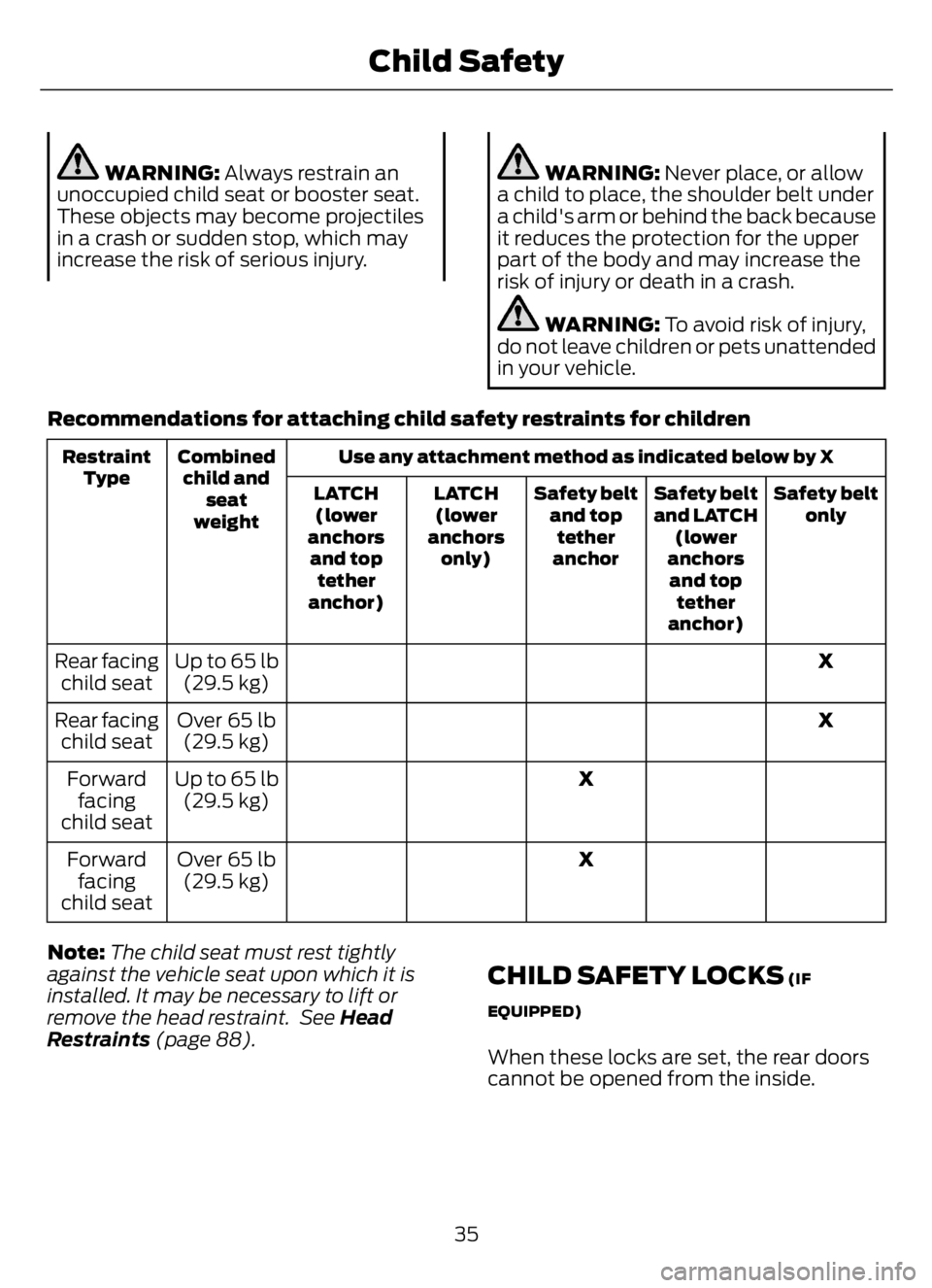
WARNING: Always restrain an
unoccupied child seat or booster seat.
These objects may become projectiles
in a crash or sudden stop, which may
increase the risk of serious injury.WARNING: Never place, or allow
a child to place, the shoulder belt under
a child's arm or behind the back because
it reduces the protection for the upper
part of the body and may increase the
risk of injury or death in a crash.
WARNING: To avoid risk of injury,
do not leave children or pets unattended
in your vehicle.
Recommendations for attaching child safety restraints for children
Use any attachment method as indicated below by X Combined
child and
seat
weight Restraint
Type
Safety belt
only Safety belt
and LATCH
(lower
anchors
and top
tether
anchor) Safety belt
and top
tether
anchor LATCH
(lower
anchors
only) LATCH
(lower
anchors
and top
tether
anchor)
X Up to 65 lb
(29.5 kg) Rear facing
child seat
X Over 65 lb
(29.5 kg) Rear facing
child seat
X Up to 65 lb
(29.5 kg) Forward
facing
child seat
X Over 65 lb
(29.5 kg) Forward
facing
child seat
Note:The child seat must rest tightly
against the vehicle seat upon which it is
installed. It may be necessary to lift or
remove the head restraint. See Head
Restraints (page 88).
CHILD SAFETY LOCKS (IF
EQUIPPED)
When these locks are set, the rear doors
cannot be opened from the inside.
35
Child Safety
Page 40 of 378
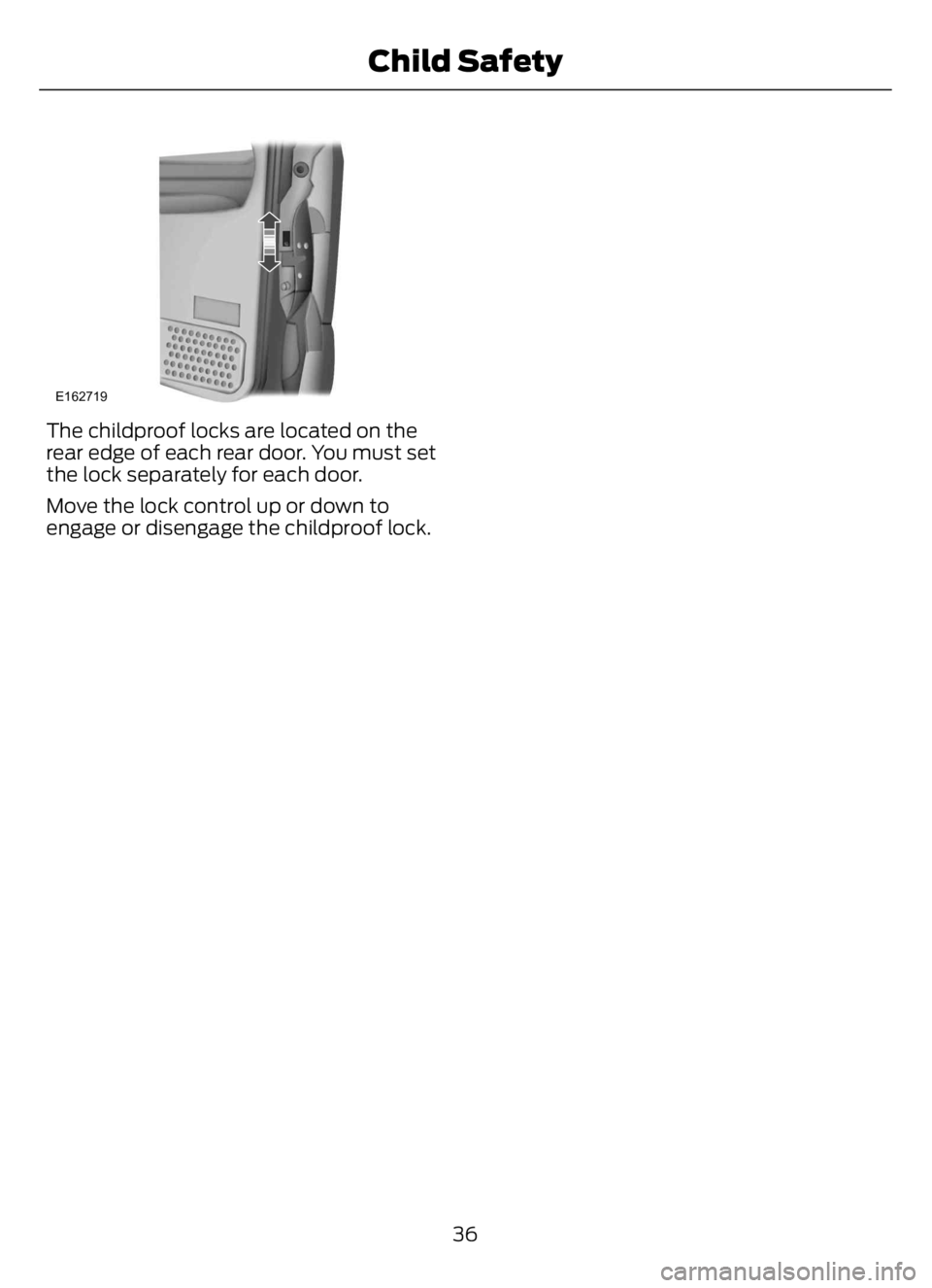
E162719
The childproof locks are located on the
rear edge of each rear door. You must set
the lock separately for each door.
Move the lock control up or down to
engage or disengage the childproof lock.
36
Child Safety
Page 41 of 378
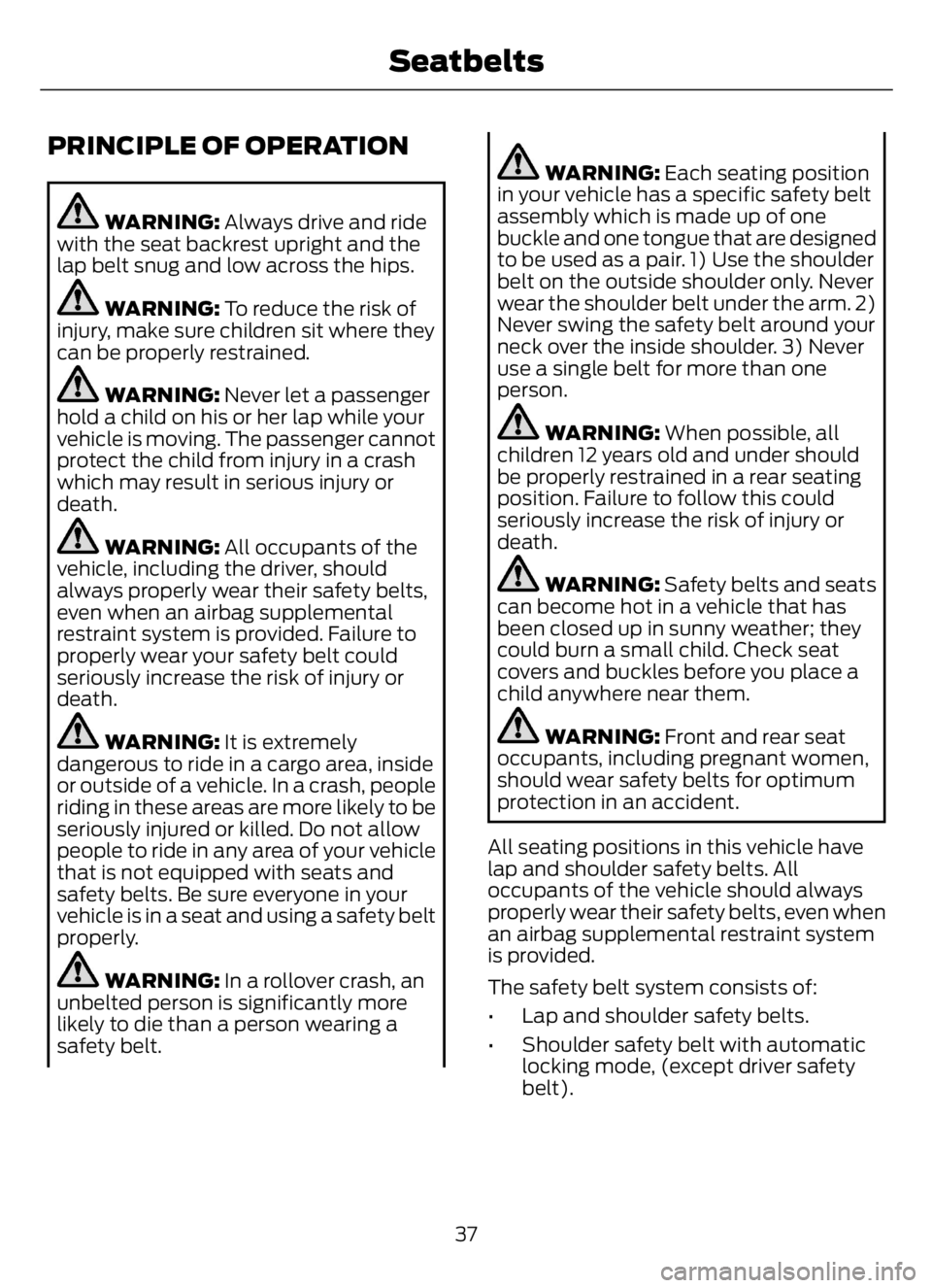
PRINCIPLE OF OPERATION
WARNING: Always drive and ride
with the seat backrest upright and the
lap belt snug and low across the hips.
WARNING: To reduce the risk of
injury, make sure children sit where they
can be properly restrained.
WARNING: Never let a passenger
hold a child on his or her lap while your
vehicle is moving. The passenger cannot
protect the child from injury in a crash
which may result in serious injury or
death.
WARNING: All occupants of the
vehicle, including the driver, should
always properly wear their safety belts,
even when an airbag supplemental
restraint system is provided. Failure to
properly wear your safety belt could
seriously increase the risk of injury or
death.
WARNING: It is extremely
dangerous to ride in a cargo area, inside
or outside of a vehicle. In a crash, people
riding in these areas are more likely to be
seriously injured or killed. Do not allow
people to ride in any area of your vehicle
that is not equipped with seats and
safety belts. Be sure everyone in your
vehicle is in a seat and using a safety belt
properly.
WARNING: In a rollover crash, an
unbelted person is significantly more
likely to die than a person wearing a
safety belt.
WARNING: Each seating position
in your vehicle has a specific safety belt
assembly which is made up of one
buckle and one tongue that are designed
to be used as a pair. 1) Use the shoulder
belt on the outside shoulder only. Never
wear the shoulder belt under the arm. 2)
Never swing the safety belt around your
neck over the inside shoulder. 3) Never
use a single belt for more than one
person.
WARNING: When possible, all
children 12 years old and under should
be properly restrained in a rear seating
position. Failure to follow this could
seriously increase the risk of injury or
death.
WARNING: Safety belts and seats
can become hot in a vehicle that has
been closed up in sunny weather; they
could burn a small child. Check seat
covers and buckles before you place a
child anywhere near them.
WARNING: Front and rear seat
occupants, including pregnant women,
should wear safety belts for optimum
protection in an accident.
All seating positions in this vehicle have
lap and shoulder safety belts. All
occupants of the vehicle should always
properly wear their safety belts, even when
an airbag supplemental restraint system
is provided.
The safety belt system consists of:
• Lap and shoulder safety belts.
• Shoulder safety belt with automatic
locking mode, (except driver safety
belt).
37
Seatbelts